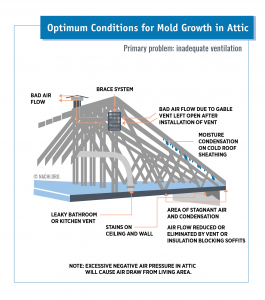Your home’s air quality may not be on your mind all the time—unless you have a mold allergy.
If you’re one of the millions of people worldwide who have allergic reactions to mold, it’s essential that you check for mold in your insulation. Symptoms of a mold allergy include a scratchy throat, sneezing, and headache. Under the right conditions, there are plenty of spaces in your home that are prone to mold infestations.
Mold needs three things to grow: a food source, mold spores, and moisture. The most common location for mold to grow is in the attic because it’s typically humid, dark, and warm due to poor ventilation — an ideal environment for mold spores to settle and colonize/grow. Although there’s no such thing as a mold-free home, mold detection, prevention and control should be on the top of your priority list.
To make sure that your home is as mold-resistant as possible, take a look at your current insulation. Insulation helps to maintain indoor temperatures and stop condensation, a key contributor to mold growth.
Inadequate or improperly installed insulation (and or vapor barrier) can cause condensation and mold growth to accelerate. At IAQ Strategies, we understand how serious a mold situation in your home can be. We’ve created this list of tips and tricks to guide you when you find mold in your insulation.

Choose The Right Insulation For The Job
Many people assume that any insulation will work when they’re remodeling or constructing a new home. Picking out the right insulation for the job can be the difference between years of increased comfort or increased mold allergies.
The two primary types of insulation are:
-
Cellulose Insulation
Cellulose is the most popular material used for home insulation. It has superior insulative properties because it’s a loose, biodegradable material. Cellulose insulation has several unique benefits—it’s a green choice for your home and ideal if you’re concerned about your environmental impact. This type of insulation is typically installed in the attic or as a blow-fill between walls.
Since it’s highly efficient and has the ability to stop air flow better than fiberglass, cellulose insulation is an excellent choice for hard-to-fill spaces.
Mold growth is also less likely to take place in cellulose insulation due to the anti-fungal properties commonly found in the cellulose itself. When you install cellulose installation over existing fiberglass, be cautious—its weight can be a concern since it can compress the fiberglass and reduce its insulating properties.
-
Fiberglass Insulation
Fiberglass insulation is made up of thin shreds of glass that create pockets to trap air and help restrict the transfer of heat. It’s naturally mold-resistant as the material itself does not provide a food source for mold.
However, due to the high amount of air that moves through fiberglass charging it with static electricity, particles of mold can be filtered out of the air trapped within.
Fiberglass insulation can also moisture and lead to condensation issues. Fiberglass must be well-maintained to prevent water vapor from creating a friendly environment for mold growth.
How To Get Rid of Mold In Insulation:
Since mold growth in insulation is directly related to moisture content, it’s necessary to target the moisture issue at the source.
If your mold issue is severe, consider one of the following home improvements:
1. Insulation Removal
Naturally, if the insulation in your home is damaged due to water or mold, you should schedule insulation removal as soon as possible. Make sure to work closely with a professional home insulation contractor who specializes in the safe removal of moldy insulation.
2. New Insulation
Once the damaged insulation has been removed, ask your insulation contractor to air seal and install new insulation immediately after the decontamination process. An experienced insulation installer will know how much insulation your home needs and can identify any unique insulation needs of your home.
3. Crawlspace Encapsulation
It’s not uncommon for indoor moisture problems to begin in the crawlspace. Crawlspace encapsulation mainly targets moisture problems at the source. The process involves installing a heavy-duty vapor barrier to restrict excess moisture.

How To Manage Mold Growth:
1. Mold Detection
Your attic provides conditions that may favor mold. If you’re greeted by an unpleasant earthy odor when you enter your attic, it’s a sign that you should get a mold inspection. Mold identification should be followed by mold removal from a professional mold removal service.
2. Identifying Mold In Insulation
The same mold that infects your insulation can also affect your home’s heating and cooling systems. As mold and moisture grow and begin to overtake large areas like your attic, saturated structure, drywall, and insulation will likely become less effective. Mold will eat and destroy the structure, roofing plywood, and drywall. However, with the help of a professional mold removal company, you can make your home safe and energy-efficient and save money on appliances and utilities each month.
3. Mold And Ventilation
When a professional conduct a mold inspection in your attic to determine if there is a contamination issue, She, he, or they, will also identify airflow issues that are conducive to mold growth. With sufficient ventilation, your attic will have significantly less chance of developing condensation/ mold growth.
It’s not recommended that you look for mold on your own because getting into contact with it or disturbing an area with a large amount of mold can disturb spores, causing them to enter into the air, and potentially spread to other areas of your home. If you have an allergy, stirring up mold particles into the air can cause allergy symptoms to worsen. If you suspect you may have mold hidden within your house, you should call for a professional mold removal service immediately.
Whether you’re building a new home or remodeling your existing one, it’s essential that you understand how insulation can impact your home—and your health. At IAQ Strategies, we ensure healthy indoor air quality for your home.
Our team of mold detection and inspection experts are fully equipped, skilled technicians who offer professional solutions in indoor analytics, moisture infiltration, and mold remediation. If you’re looking for a mold removal company to free your home of mold, IAQ Strategies is your ideal choice.

